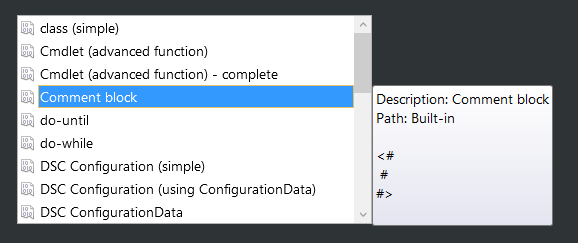How do you comment out code in PowerShell (1.0 or 2.0)?
10 Answers
In PowerShell V1 there's only # to make the text after it a comment.
# This is a comment in PowerShell
In PowerShell V2 <# #> can be used for block comments and more specifically for help comments.
#REQUIRES -Version 2.0
<#
.SYNOPSIS
A brief description of the function or script. This keyword can be used
only once in each topic.
.DESCRIPTION
A detailed description of the function or script. This keyword can be
used only once in each topic.
.NOTES
File Name : xxxx.ps1
Author : J.P. Blanc ([email protected])
Prerequisite : PowerShell V2 over Vista and upper.
Copyright 2011 - Jean Paul Blanc/Silogix
.LINK
Script posted over:
http://silogix.fr
.EXAMPLE
Example 1
.EXAMPLE
Example 2
#>
Function blabla
{}
For more explanation about .SYNOPSIS and .* see about_Comment_Based_Help.
Remark: These function comments are used by the Get-Help CmdLet and can be put before the keyword Function, or inside the {} before or after the code itself.
5 Comments
B.1.2 Comments.{ (inside the function). In particular, I had trouble making it work outside with script module functions.You use the hash mark like this:
# This is a comment in PowerShell
Wikipedia has a good page for keeping track of how to do comments in several popular languages:
Comments
Single line comments start with a hash symbol, everything to the right of the # will be ignored:
# Comment Here
In PowerShell 2.0 and above multi-line block comments can be used:
<#
Multi
Line
#>
You could use block comments to embed comment text within a command:
Get-Content -Path <# configuration file #> C:\config.ini
Note: Because PowerShell supports Tab Completion you need to be careful about copying and pasting Space + TAB before comments.
1 Comment
Here
# Single line comment in PowerShell
<#
--------------------------------------
Multi-line comment in PowerShell V2+
--------------------------------------
#>
Use a hashtag followed by a white space(!) for this:
# Comment here
Do not forget the white space here! Otherwise it can interfere with internal commands.
E.g., this is not a comment:
#requires -runasadmin
5 Comments
#requires -runasadmin)? In what way does it interfere with internal commands? Please respond by editing your answer, not here in comments (without "Edit:", "Update:", or similar - the answer should appear as if it was written today).#Requires statement, which allows a script to specify some of its prerequisites. This answer seems to be suggesting to always make a space the first character of your comments so as to avoid a comment unintentionally being treated as a #Requires statement; not only does that seem incredibly unlikely, if a #Requires statement is unsatisfied or of incorrect format then an error is thrown, anyways.# and no whitespace afterward, it does not act like a comment...try #!/bin/sh as the start...it sends to standard error: "'#!' is not recognized as an internal or external command, operable program or batch file."I'm a little bit late to this party but seems that nobody actually wrote all use cases. So...
Only supported version of PowerShell these days (fall of 2020 and beyond) are:
- Windows PowerShell 5.1.x
- PowerShell 7.0.x.
You don't want to or you shouldn't work with different versions of PowerShell.
Both versions (or any another version which you could come around WPS 3.0-5.0, PS Core 6.x.x on some outdated stations) share the same comment functionality.
One line comments
# Get all Windows Service processes <-- one line comment, it starts with '#'
Get-Process -Name *host*
Get-Process -Name *host* ## You could put as many ### as you want, it does not matter
Get-Process -Name *host* # | Stop-Service # Everything from the first # until end of the line is treated as comment
Stop-Service -DisplayName Windows*Update # -WhatIf # You can use it to comment out cmdlet switches
Multi line comments
<#
Everyting between '< #' and '# >' is
treated as a comment. A typical use case is for help, see below.
# You could also have a single line comment inside the multi line comment block.
# Or two... :)
#>
<#
.SYNOPSIS
A brief description of the function or script.
This keyword can be used only once in each topic.
.DESCRIPTION
A detailed description of the function or script.
This keyword can be used only once in each topic.
.NOTES
Some additional notes. This keyword can be used only once in each topic.
This keyword can be used only once in each topic.
.LINK
A link used when Get-Help with a switch -OnLine is used.
This keyword can be used only once in each topic.
.EXAMPLE
Example 1
You can use this keyword as many as you want.
.EXAMPLE
Example 2
You can use this keyword as many as you want.
#>
Nested multi line comments
<#
Nope, these are not allowed in PowerShell.
<# This will break your first multiline comment block... #>
...and this will throw a syntax error.
#>
In code nested multi line comments
<#
The multi line comment opening/close
can be also used to comment some nested code
or as an explanation for multi chained operations..
#>
Get-Service | <# Step explanation #>
Where-Object { $_.Status -eq [ServiceProcess.ServiceControllerStatus]::Stopped } |
<# Format-Table -Property DisplayName, Status -AutoSize |#>
Out-File -FilePath Services.txt -Encoding Unicode
Edge case scenario
# Some well written script
exit
Writing something after exit is possible but not recommended.
It isn't a comment.
Especially in Visual Studio Code, these words baffle PSScriptAnalyzer.
You could actively break your session in VS Code.
5 Comments
In code nested multi line comments is certainly a new thing rarely who knows and other answers don't say itYou can make:
(Some basic code) # Use "#" after a line and use:
<#
for more lines
...
...
...
..
.
#>

#is not a comment in a Windows or Microsoft based scripting language.helpdocumentation with examples, method and member lists, etc.